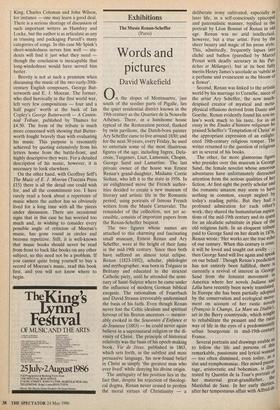Exhibitions
Words and pictures
David Wakefield
On the slopes of Montmartre, just south of the seedier parts of Pigalle, lies the quiet residential district known in the 19th century as the Quartier de la Nouvelle Athenes. There, in a handsome house typical of the Restoration period, flanked by twin pavilions, the Dutch-born painter Ary Scheffer came to live around 1830; and for the next 30 years, every Friday, he used to entertain some of the most illustrious figures of the age, including Ingres, Dela- croix, Turgenev, Liszt, Lamenais, Chopin, George Sand and Lamartine. The last private owner of the house was Ernest Renan's grand-daughter, Madame Corrie Siohan, who left it to the state in 1956. In an enlightened move the French author- ities decided to create a new museum of literary and artistic life in the Romantic period, using portraits of famous French writers from the Musee Carnavalet. The remainder of the collection, not yet ac- cessible, consists of important papers from the Renan-Scheffer bequest.
The two figures whose names are attached to this charming and fascinating small museum, Ernest Renan and Ary Scheffer, were at the height of their fame in the mid-19th century. Since then both have suffered an almost total eclipse. Renan (1823-1892), scholar, philologist and mythographer, was born in Treguier in Brittany and educated in the strictest Catholic piety, until he attended the semi- nary of Saint-Sulpice where he came under the influence of modern, German biblical exegesis. The rationalism of Feuerbach and David Strauss irrevocably undermined the basis of his faith. Even though Renan never lost the Celtic idealism and spiritual fervour of his Breton ancestors — memor- ably evoked in the Souvenirs d'Enfance et de Jeunesse (1883) — he could never again believe in a supernatural religion or the di- vinity of Christ. The principle of historical relativity was the basis of his epoch-making book, Vie de Jesus, published in 1863, which sets forth, in the subtlest and most persuasive language, his new-found belief in Christ as simply 'the greatest man who ever lived' while denying his divine origin.
The ambiguity of his position lies in the fact that, despite his rejection of theologi- cal dogma, Renan never ceased to profess the moral virtues of Christianity — a deliberate irony cultivated, especially in later life, in a self-consciously episcopal and paternalistic manner, typified in the portrait by Leon Bonnat of Renan in old age. Renan was no arid intellectual, however, but a true artist. First by the sheer beauty and magic of his prose style. This, admittedly, frequently lapses into cliché and bathos (parodied by Marcel Proust with deadly accuracy in his Pas- tiches et Mélanges), but at its best fully merits Henry James's accolade as 'subtle as a perfume and evanescent as the bloom of a flower'.
Second, Renan was linked to the artistic world by his marriage to Cornelie, niece of the artist Ary Scheffer, the now much- despised creator of mystical and meta- physical effusions derived from Dante and Goethe. Renan evidently found his son-in- law's work much to his taste, for in an essay in the Etudes d'histoire religieuse he praised Scheffer's 'Temptation of Christ' as the appropriate expression of an enlight- ened 19th-century religious temper. The writer returned to the question of religious art in several of his books.
The other, far more glamorous figure who presides over this museum is George Sand, the female novelist whose amorous adventures have unfortunately distracted attention from the serious qualities of her fiction. At first sight the portly scholar and the romantic amazon may seem to have nothing in common, except neglect by today's reading public. But they had profound admiration for each other's work; they shared the humanitarian aspira- tions of the mid-19th century and its quest for an idealistic substitute in place of the old religious faith. In an eloquent tribute paid to George Sand on her death in 1876, Renan wrote: 'Her works are the true echo of our century. When this century is over, it will be loved and sought out avidly . • • then George Sand will live again and speak on our behalf.' Though Renan's prediction has not entirely been fulfilled, there is currently a revival of interest in George Sand from the feminist movement in America where her novels fndiana and Lelia have recently been newly translated. In Europe she has been partially adopted by the conservation and ecological move" ment on account of her rustic novels (Francois le Champi, La Mare au Diable), set in the Berry countryside, which sought to rehabilitate the peasant and the rural way of life in the eyes of a predominant) urban bourgeoisie in mid-19th-century France. Several portraits and drawings enable us to follow the life and persona of this remarkable, passionate and lyrical woman — too often dismissed, even today, as 3 slut and nymphomaniac. Her mixed paren- tage, aristocratic and bohemian, is illy's: trated by Quentin de la Tour's portrait o; her maternal great-grandfather, th Marechal de Saxe. In her early thirtit after her tempestuous affair with Alfred Musset, George Sand changed from the dark-haired sensual young woman into the rather severe matronly figure painted by Couture in 1838. Her son Maurice was a pupil of Delacroix and a gifted artist in his own right who illustrated his mother's novels in a series of drawings in the dining-room at Nohant. Sand's greatest and most sympathetic interpreter was un- doubtedly Delacroix himself who, apart from two well-known portraits of her (not here), made a series of wonderful drawings of the writer's garden at Nohant; two are exhibited here, dated 1843 and 1864. His pastel sketch for the last scene of Lelia reveals a deep intuitive understanding of Sand's passionate genius. One leaves the museum only wishing for more. What could be more interesting than a complete iconography of 19th-century literature?















































 Previous page
Previous page